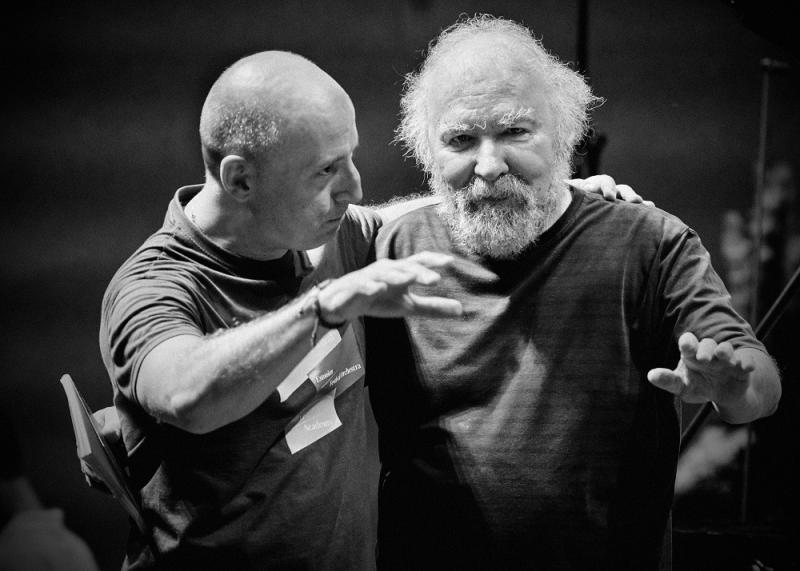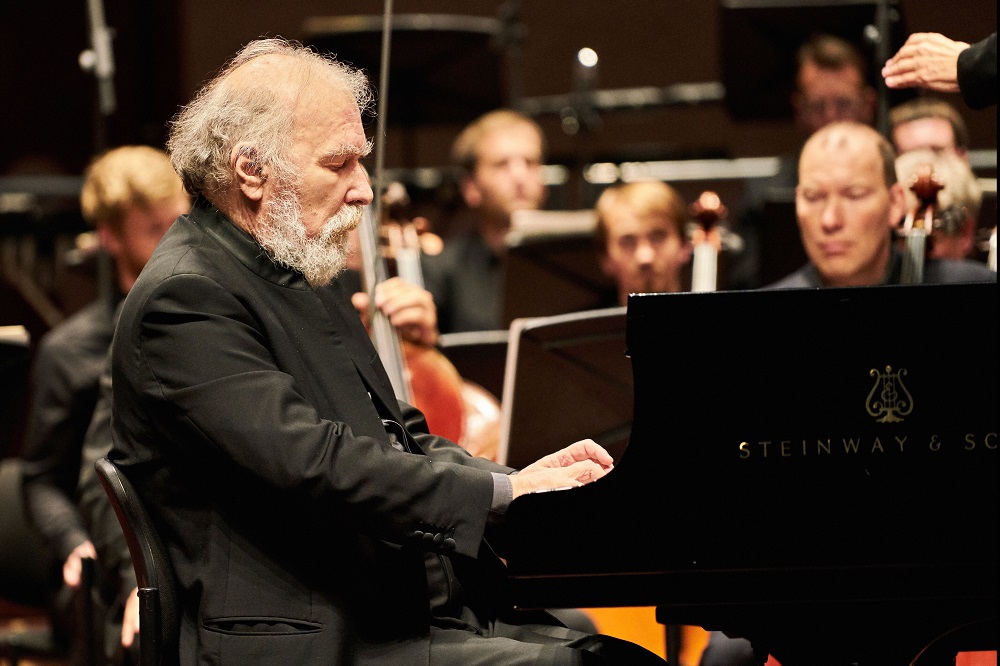Lupu, Philharmonia, Järvi, RFH review - concerto magical in parts, symphony stupendous
theartsdesk.com
David Nice
4.02.2019

Paavo Järvi and Radu Lupu in rehearsal for Beethoven's Fourth Piano Concerto at the 2017 Pärnu Music FestivalAll images by Kaupo Kikkas
Pianists most often cite Radu Lupu alongside Martha Argerich and Grigory Sokolov as the greatest. So it was hardly surprising to see so many top musicians in a packed audience, buzzing with expectation for the 73-year-old Romanian's most recent UK appearance with a conductor he respects, Paavo Järvi. Lupu appeared at Steven Isserlis's 60th birthday event at the Wigmore towards the end of last year, but before that hasn't been seen here since 2014. I heard him then, but in Stockholm, giving a magisterial performance of Beethoven's Third Piano Concerto. Last night's Fourth was exquisite at times, not quite of this world, and not always in a good sense. But he has apparently said it will be his last appearance, so we had better treasure what was best about it.
The subtlety is what many seek in Lupu's playing; there's a Schumann disc including Kinderszenen which is really heaven on earth. Now, though, it's not so much wrong notes – no-one minds those, up to a point, when listening to a legend – as missing ones in what should be perfect runs: pearls on a line, but with some gaps. The magic was often there, especially in the rapt mystery Beethoven introduces at the start of the first-movement development,and there was some fascinating left-hand accenting. But the composer's own, longer cadenza needs moments of fierceness, and so does Orpheus, in pleading with the Furies of the central drama. While there was nimble wit in the finale, including a lovely moment of rapport with conductor and orchestra just before the end, you sometimes felt Lupu, for all his watchfulness, was playing to some inner rhythm that didn't always correspond with reality.
Järvi, hawk-eyed for every slight waywardness, made sure that the Philharmonia matched the soloist for ghost voices, and one of the finest moments in the performance came near the beginning, violins hovering ever so slightly in the air on the top note of the second theme. Clearly this is a long-term partnership which works, but now there's more give from the orchestra than from the pianist. Lupu's encore (the pianist pictured below at the 2017 Pärnu Music Festival) was the inward poetry of Brahms's E flat Intermezzo, Op 117 No. 1; I was ready to be moved, but alongside the private world Lupu conjured the pulse seemed to falter. The rapturous ovation, you felt, was more for auld lang syne, but a little sympathetic imagination could find its way through to Lupu's special incandescence.
David Nice
4.02.2019
Delicacy from the legendary Romanian in Beethoven while Rachmaninov electrifies

Paavo Järvi and Radu Lupu in rehearsal for Beethoven's Fourth Piano Concerto at the 2017 Pärnu Music FestivalAll images by Kaupo Kikkas
Pianists most often cite Radu Lupu alongside Martha Argerich and Grigory Sokolov as the greatest. So it was hardly surprising to see so many top musicians in a packed audience, buzzing with expectation for the 73-year-old Romanian's most recent UK appearance with a conductor he respects, Paavo Järvi. Lupu appeared at Steven Isserlis's 60th birthday event at the Wigmore towards the end of last year, but before that hasn't been seen here since 2014. I heard him then, but in Stockholm, giving a magisterial performance of Beethoven's Third Piano Concerto. Last night's Fourth was exquisite at times, not quite of this world, and not always in a good sense. But he has apparently said it will be his last appearance, so we had better treasure what was best about it.
The subtlety is what many seek in Lupu's playing; there's a Schumann disc including Kinderszenen which is really heaven on earth. Now, though, it's not so much wrong notes – no-one minds those, up to a point, when listening to a legend – as missing ones in what should be perfect runs: pearls on a line, but with some gaps. The magic was often there, especially in the rapt mystery Beethoven introduces at the start of the first-movement development,and there was some fascinating left-hand accenting. But the composer's own, longer cadenza needs moments of fierceness, and so does Orpheus, in pleading with the Furies of the central drama. While there was nimble wit in the finale, including a lovely moment of rapport with conductor and orchestra just before the end, you sometimes felt Lupu, for all his watchfulness, was playing to some inner rhythm that didn't always correspond with reality.
Järvi, hawk-eyed for every slight waywardness, made sure that the Philharmonia matched the soloist for ghost voices, and one of the finest moments in the performance came near the beginning, violins hovering ever so slightly in the air on the top note of the second theme. Clearly this is a long-term partnership which works, but now there's more give from the orchestra than from the pianist. Lupu's encore (the pianist pictured below at the 2017 Pärnu Music Festival) was the inward poetry of Brahms's E flat Intermezzo, Op 117 No. 1; I was ready to be moved, but alongside the private world Lupu conjured the pulse seemed to falter. The rapturous ovation, you felt, was more for auld lang syne, but a little sympathetic imagination could find its way through to Lupu's special incandescence.

Beethoven's Coriolan Overture kickstarted a standard programme with Järvistretching dramatic pauses between the lion's roars, but as the work stalked onwards, it became a bit of a distraction to find a cough planted in every one of the later silences. Rachmaninov's textures are more consistently lush in his biggest symphonic epic, covering the coughs, though to be fair the audience did seem to be perfectly still in the dying fall of the Adagio, violas fading to nothing before Järviheld the silence and plunged straight into the festival finale.
The Second Symphony is a work Järvi's recorded with the Cincinnati Symphony Orchestra; the Philharmonia also knows it well from Ashkenazy's several performances, and the present team had just been using it as a calling-card on tour. So one expected the polish. But how alive it all was in every phrase, Järvi's subtle rubato lending a special animation. Without the depth of sound and the humanity, it might have seemed a bit hard-pressed at times; but Järvi knows not to wallow in the many lush string melodies, and the one which comes on the heels of what was here an incredibly lively and focused main scherzo theme has never sounded more convincing in its place.
There was consistent richness, too, from the Philharmonia lower strings, a highly artistic timpanist, Antoine Siguré, and especially the horns, never better, revelatory in the low snarls that darken the canvas from time to time. Of course it depends on what Järvi the brilliant globetrotter wants to do in 2021 – he takes up a post as principal conductor of the Zurich Tonhalle Orchestra this autumn – but the Philharmonia is spoilt for choice of successor to Esa-Pekka Salonen between this regular visitor and principal guest conductors Jakub Hrůša and Santtu-Matias Rouvali. Exciting times, at least for our (threatened) musical world-within-world.
https://theartsdesk.com/classical-music/lupu-philharmonia-j%C3%A4rvi-rfh-review-concerto-magical-parts-symphony-stupendous
The Second Symphony is a work Järvi's recorded with the Cincinnati Symphony Orchestra; the Philharmonia also knows it well from Ashkenazy's several performances, and the present team had just been using it as a calling-card on tour. So one expected the polish. But how alive it all was in every phrase, Järvi's subtle rubato lending a special animation. Without the depth of sound and the humanity, it might have seemed a bit hard-pressed at times; but Järvi knows not to wallow in the many lush string melodies, and the one which comes on the heels of what was here an incredibly lively and focused main scherzo theme has never sounded more convincing in its place.
There was consistent richness, too, from the Philharmonia lower strings, a highly artistic timpanist, Antoine Siguré, and especially the horns, never better, revelatory in the low snarls that darken the canvas from time to time. Of course it depends on what Järvi the brilliant globetrotter wants to do in 2021 – he takes up a post as principal conductor of the Zurich Tonhalle Orchestra this autumn – but the Philharmonia is spoilt for choice of successor to Esa-Pekka Salonen between this regular visitor and principal guest conductors Jakub Hrůša and Santtu-Matias Rouvali. Exciting times, at least for our (threatened) musical world-within-world.
https://theartsdesk.com/classical-music/lupu-philharmonia-j%C3%A4rvi-rfh-review-concerto-magical-parts-symphony-stupendous
Comments